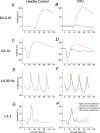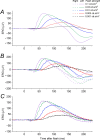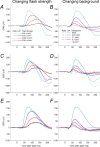Selective Impairment of Rod-Driven Vision in Vitamin A Deficiency: Insights From Examining the Effect of Desensitizing Backgrounds
- PMID: 40938071
- PMCID: PMC12439512
- DOI: 10.1167/iovs.66.12.30
Selective Impairment of Rod-Driven Vision in Vitamin A Deficiency: Insights From Examining the Effect of Desensitizing Backgrounds
Abstract
Purpose: The purpose of this study was to explore whether nyctalopia in vitamin A deficiency (VAD) is attributable to simple reduction in quantal catch or to an "equivalent background" phenomenon.
Methods: Five individuals were recruited for experimental electroretinograms (ERGs), including three healthy participants (aged 21 to 47 years), one patient with VAD (aged 70 years), and one patient with GNAT2-associated achromatopsia (aged 43 years). Recordings used conductive fiber electrodes and followed dark adaptation and mydriasis. Dim flashes of varying strengths were delivered in the dark to mimic reduction in quantal catch; flashes of fixed strength (0.03 scotopic cd·s/m2) were delivered on dim blue backgrounds.
Results: International standard recordings in the patient with VAD showed selective attenuation of dark-adapted responses in severe deficiency, which normalized following treatment. Light-adapted responses did not change. In experimental recordings, both reducing flash strength and applying dim backgrounds reduced ERG amplitude. Reducing flash strength also increased latency of the response, whose rising phase and peak became progressively delayed. Dim backgrounds did not prolong latency. This was seen in all participants, including the patient with achromatopsia, indicating that this was a property of the rod system. In moderate VAD, the dim-flash response was reduced, but not delayed, resembling the response seen in the presence of a dim background.
Conclusions: Our findings indicate that rod system desensitization in VAD likely arises from an "equivalent background" effect, probably arising from activation of phototransduction by free opsin. Activation to a similar degree is known not to occur in cones, helping explain why VAD selectively affects night vision.
Conflict of interest statement
Disclosure:
Figures





References
-
- McBain VA, Egan CA, Pieris SJ, et al.. Functional observations in vitamin A deficiency: diagnosis and time course of recovery. Eye (Lond). 2007; 21(3): 367–376. - PubMed
MeSH terms
Grants and funding
LinkOut - more resources
Full Text Sources

